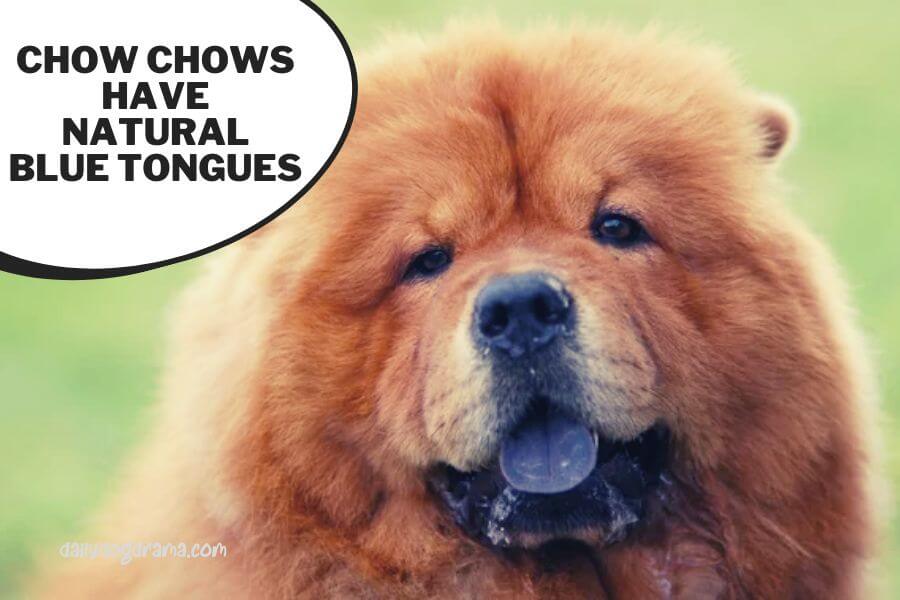Do you know what DOG ESSENTIALS you are missing out? Find out now!
Zack Keithy, our author, is a certified veterinarian technician (UC Blue Ash) for over 6 years (contact him here). The articles written here are based on his expertise and experience, combined with a review by our expert vet reviewers including Dr M. Tarantino. Learn more about us here.
You’re probably wondering: Why is my dog’s tongue blue?
If you’ve ever seen your dog’s tongue turn blue, you know how scary it can be.
It’s not every day that your fur baby has a blue tongue and you definitely want to know what caused it and if there’s anything you can do about it.
I have seen a few myself during my vet tech days, and if you are witnessing one, you should take your dog to the vet right away (unless you own a Chow Chow or Shar Pei).
Otherwise, read on as we dissect this issue.
Medical Questions? Talk to a Veterinarian 24/7.
Connect one-on-one with a licensed vet who will answer your questions in minutes.
*Article may contain affiliate links to retailers like Amazon and Chewy. Learn more on our disclosure page.
- What is the Normal Color of a Dog’s Tongue?
- Dog Breeds With Different-colored Tongues
- Why Does My Dog Have a Blue Tongue?
- What is Cyanosis in Dogs?
- What Are the Causes of Cyanosis?
- What Are the Warning Signs of Cyanosis?
- What Do You Do When Your Dog's Tongue is Blue?
- Can Cyanosis in Dogs Be Treated?
- What Can I Expect for My Dog With Cyanosis?
- Signs of Cancer on a Dog’s Tongue
- Frequently Asked Questions (FAQs)
- In Conclusion: Why is My Dog's Tongue Blue?
What is the Normal Color of a Dog’s Tongue?
A healthy dog tongue should typically be a deep pink in color.
The best time to examine your dog’s tongue is when he is at rest because if it is hot, for example after playing, its tongue will typically be red because of the heat that is being released from the vessels.
The color is more vibrant and pinker when your dog is younger and slowly turns darker as it ages.
Don’t freak out if you see a different color on your dog’s tongue.
It might just be pigmentation, which is common in some breeds such as the Chow Chow.
Here are other variations and what they can mean.
Pale pink
Pale pink in an older dog may be normal, but it might also indicate a slight decline in the animal’s vitality.
Due to the reduction in red blood cells, possibly caused by anemia, the tongue can seem whiter.
Your veterinarian can check for anemia by conducting routine blood tests, which should be performed annually, especially as your dog ages.
Red
It is normal to see a red tongue in dogs that are panting. This happens because the body is cooling off through the respiratory system.
However, if this is not the case and you see it during resting time, it may indicate an increase in body heat that is caused by inflammation or pain.
Yellow
A yellow tongue is frequently an indication of liver or gallbladder issues (just like when humans turn yellow – commonly known as jaundice).
The yellow coloring is caused by a high bilirubin content that is traveling through a dog’s body, and is more likely to affect the skin, eyes, and gums.
Purple or Lavender
A purple or lavender tongue can indicate problems with your dog’s organs.
The pancreas, liver, and small and large intestines are areas that might be affected, leading to this discoloration of your dog’s tongue.
We also observe them in dogs who are taking chemotherapy drugs and those who have long-term conditions like irritable bowel syndrome.
Black
I don’t think there are dogs with entirely black tongues, but rather they have black spots on them.
There is usually nothing to worry about in such cases.
Blue
A blue tongue can indicate a medical condition known as Cyanosis unless you own a Chow Chow or Chinese Shar-Pei, the only two dog breeds in the world with naturally blue tongues.
Not only does the tongue turn blue, but the skin can too, and they are all related to a reduced oxygen level in the blood vessels close to the surface of these tissues.
I will discuss this in detail in the following sections.
Dog Breeds With Different-colored Tongues
The majority of dogs will have a normal pink tongue, but did you know that there are a few breeds that have something different?
Here’s a list of dogs that have spotted tongues instead:
- Akitas
- Airedales
- Australian Shepherds
- Dalmatian
- Dobermans
- German Shepherd
- Golden Retrievers
- Irish Setters
- Labrador Retriever
- Mastiffs
- Newfoundlands
- Pitbulls
- Pomeranians
- Rottweiler
Some crossbred dogs might also develop a blueish-black tongue similar to Chow Chows, such as the Eurasier.
Doggy says, you might be keen to read too: When can Golden Retriever puppies go up and down stairs?
Why Does My Dog Have a Blue Tongue?
Dogs with blue tongues have a condition called cyanosis, which is caused by oxygen deprivation in the blood.
Cyanosis can occur for a number of reasons, but if your dog’s tongue is bluish-gray or blackish-blue, it’s likely due to the lack of oxygen in his bloodstream.
What is Cyanosis in Dogs?
Cyanosis is when the skin and mucous membranes (such as the gums) turn blue when the red blood cells are unable to carry enough oxygen to the body.
It can be caused by a number of various disorders that affect the respiratory, cardiovascular, or both systems.
The underlying cause of the low oxygen levels will determine the course of treatment.
What Are the Causes of Cyanosis?
The respiratory system is frequently to blame for dog Cyanosis, and is often classified as either central or peripheral.
The following are some of the most typical respiratory system-related causes:
- Asthma
- Larynx suffering from paralysis
- Poisoning
- Muscle damage
- Parasites in the lungs
- Inhaling smoke
- Lungs being bruised
- Pneumonia
- Sections of the trachea collapsing
What Are the Warning Signs of Cyanosis?
The most immediate and obvious warning sign you need to pay attention to is your dog’s tongue and skin turning a different color that is close to blue and purple.
This often indicates that your dog is starting to oxygenate poorly, and although not critical yet, still requires a check by your vet who can then prescribe a treatment.
This initial exam may include a measurement of the dog’s oxygenation levels using a small device known as a pulse oximeter on an area of your dog’s body such as the tongue or tip of the ear.

What Do You Do When Your Dog’s Tongue is Blue?
If you notice your dog’s tongue has turned blue, you need to arrange a visit to the vet very soon.
You should try to send your dog to the emergency vet right away, but if not, you definitely need to be doing it by the next day to seek a diagnosis.
Can Cyanosis in Dogs Be Treated?
Depending on the underlying cause, treatment for cyanosis typically includes immediate oxygen therapy as well as certain types of medications to aid in breathing.
This includes the use of diuretics, antibiotics, or even steroids.
The prognosis varies depending on the root cause, but in general, the sooner you get to the veterinarian for treatment, the better the prognosis.
A special diet might be recommended by your vet in some cases.
What Can I Expect for My Dog With Cyanosis?
The veterinary health care staff regularly watches the situation when a dog is hospitalized for cyanosis so they can react rapidly to any changes in the dog’s condition, very much like a patient in intensive care.
Once your dog is back at home, it will be crucial to keep an eye on his gum color, breathing rate, and level of activity.
The underlying medical condition that led to the cyanosis will have a major impact on your dog’s long-term outlook.
If it was due to a heart or lung disease, vets tend not to be overly optimistic and your dog is likely to require future consults again.
Signs of Cancer on a Dog’s Tongue
Besides Cyanosis, you might also be concerned if your dog is actually suffering from tongue cancer (Squamous Cell Carcinoma).
What you should know is that these two conditions are very much different, so you are unlikely to mistake one for the other.
When a dog has tongue cancer, it exhibits the following symptoms (note that they are quite different from Cyanosis):
- Bad Breath (halitosis)
- Blood coming out from the mouth
- Difficulty chewing and eating (dysphagia)
- Excessive drooling
- Loose teeth
- Small white growth on the tongue
- White spots under the tongue
- Weight loss
Frequently Asked Questions (FAQs)
Is my dog’s purple tongue a sign of a medical problem?
Yes, it is possible that your dog may have a medical problem such as a heat injury, poisoning, or Cyanosis. This is often accompanied by difficulty breathing, and you need to send your dog to the emergency vet right away.
Is my dog a Chow Chow mix?
The best way to find out is to ask your breeder, the previous owner, the rescue, or use a dog DNA test kit to determine with the highest accuracy. I recommend getting the kit from Embark.
Can stress cause a dog’s tongue to turn blue?
This is highly unlikely in normal dogs, but it is possible to happen to a dog with an existing heart problem. When faced with danger or in a high-stress situation, its blood may not circulate properly, resulting in its tongue turning blue.
Is cyanosis in dogs fatal?
Not always, but it is possible, especially if the dog is not being treated as soon as possible. When there is not enough oxygen circulating through the body, organs will fail, which will lead to death.
In Conclusion: Why is My Dog’s Tongue Blue?
Cyanosis can be a very serious and dangerous condition for your pet dog, and action must be taken swiftly to ensure it gets treated quickly.
The only way to know what is causing your dog’s tongue to turn blue is by taking it to a vet.
The vet will perform an examination and do blood work to determine what the issue is.
This is not a condition you want to leave untreated for too long, as it can be fatal.
I hope things work out well for you and your dog soon.
Consider browsing other dog care articles here too:
Can dogs get ingrown whiskers?
Why is my puppy shivering after a bath?
You’ve made it to the end, but I hope it’s not the end of our journey. We want to hear your voice! Share your thoughts, problems, suggestions, or anything related to your dog in the comments section. And don’t forget to join our newsletter today too.



